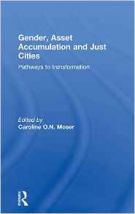Gender, Asset Accumulation and Just Cities: Pathways to Transformation

Gender, Asset Accumulation and Just Cities is truly a collective endeavour led by its editor Caroline Moser. Following the methodology of an earlier volume, this book’s contributors engaged in a workshop debate to discuss the nexus of gender, assets and just cities, and to agree upon the book’s overall theoretical focus and contents. Grounded in the World Urban Forum 7’s themes of urban equality and building just cities, its chapters explore specific issues around gendered asset accumulation and transformation for just cities.
Chapter 1 by Moser sets out the introduction. She highlights that despite growing attention and endeavours towards “sustainability” and “resilience”, gaps still exist in understanding the complexities of urbanization, in particular “the gendered nature of urban asset ownership, and the accumulation of asset portfolios” (page 1). Following a summary of the book’s context, Moser discusses the asset accumulation framework and feminist debates around the concept of “transformation”. She explains that these form the background for gendered asset pathways to empowerment and transformation, which guide the rest of this book.
Supported by ethnographic material collected among low-income women, Chapter 2 questions the extent to which female household headship can be an “asset” in creating more gender-equitable cities. Chapter 3 then examines the intergenerational accumulation of gendered assets, using comparative longitudinal data on households in Guayaquil, Ecuador. It considers whether women’s accumulation of assets empowers them to challenge power relations in a transformative manner (page 41). Drawing upon Informal Economy Monitoring Study data, Chapter 4 explores both the ability of, and opportunities for, informal workers to accumulate and maintain productive assets through their work. Chapter 5 then discusses gendered inequalities in access to land and housing. It explores to what degree women can access suitable housing, the effectiveness of legal reforms to improve access to secure tenure, and how laws and households influence one another.
Outlining the experience of South Africa’s mass-subsidized housing programme, Chapter 6 identifies the gendered contradictions in South Africa’s state housing. Chapter 7 describes the experience of Shack/Slum Dwellers International (SDI) – how its approach and tools relate to gender transformations and just cities, and how SDI has transitioned to strengthening asset accumulation. Chapter 8 then explores a gendered approach to transport planning and both its interaction with asset accumulation and its articulation in the just city (page 135).
Moving on to look at gender-based violence (GBV), Chapter 9 uses an asset framework perspective to identify urban-specific triggers behind GBV. In Chapter 10 the transformative potential of “disasters” to create more equitable and just cities is explored through the differential gendered destruction and reconstruction of assets (page 165). And to conclude, moving from large-scale disasters to gradual changes in severe weather patterns associated with climate change, Chapter 11 uses an asset adaptation framework to explore the gendered nature of asset adaptation strategies for dealing with climate change.
Book note prepared by Hannah Keren Lee
Search the Book notes database
Our Book notes database contains details and summaries of all the publications included in Book notes since 1993 - with details on how to obtain/download.
Use the search form above, or visit the Book notes landing page for more options and latest content.
For a searchable database for papers in Environment and Urbanization, go to http://eau.sagepub.com/

